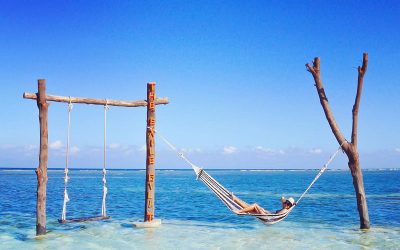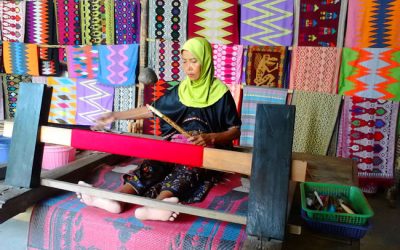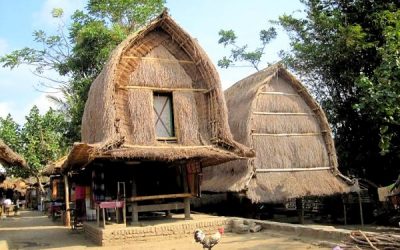Home / Batik Regions – Eastern Indonesia – West Nusa Tenggara / Rinjani – Mandalika UNESCO Global Geopark
Natural Destination
Experience the tropical nature!
Rinjani – Mandalika UNESCO Global Geopark
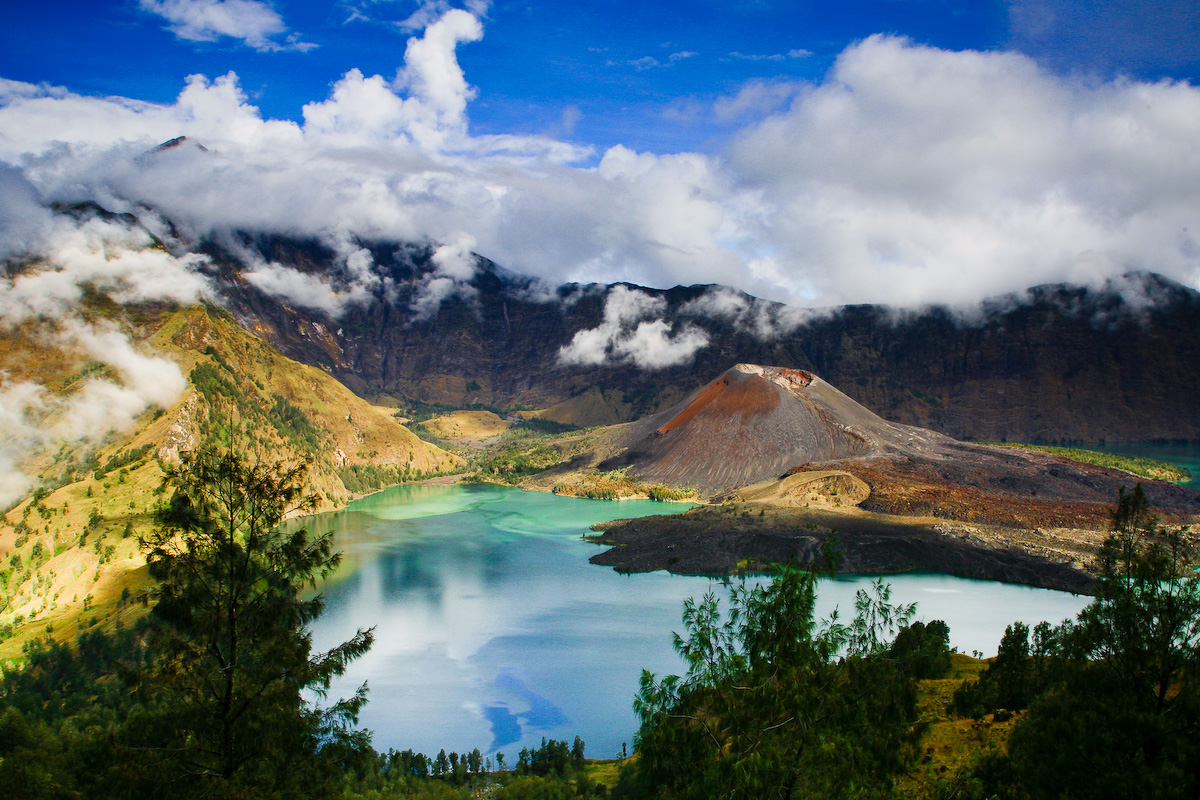
Rinjani Volcano and Segara Crater Lake in Lombok (photo: Mostbeautifulscenery)
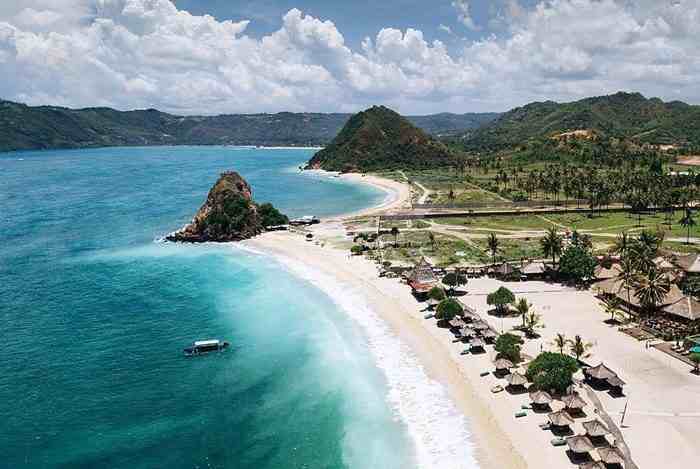
Mandalika Beach in Lombok (photo: Suara Jatim)
Rinjani – Mandalika – UNESCO Global Geopark
Once upon a time, the legend says that the beach of Mandalika is the site where the Princess of Mandalika sacrificed herself for the community of Lombok islands. Possessing great natural diverse landscape comprising savanna, tropical forest, and marine biodiversity, Rinjani volcano mountain including Mandalika coastal region were designated as UNESCO Global Geopark in 2018. The geopark region spans the area of about 2800 km², where certain spots are developed into several ecotourism sites offering varied cultural experience and natural activities. As the host of the next 2021 F1 MotoGP competition, Indonesian government is currently building an F1 circuit on the board of Mandalika coastal geopark. This project is also aimed at creating sustainable sport tourism which is also connected to the conservation of world class geopark. Visit Rinjani and have your most memorable vacation!
Tourist Attractions in West Nusa Tenggara
Gili Trawangan Beach
Do you ever imagine to get exiled on the beach with brilliant white sand and blue crystalline water?
Sukarara Textile Village
Located in Lombok island, this village is known for its flourishing weaving
Sade – Bayan Lombok Cultural Villages
Famous for its cultural destination, Lombok island of West Nusa Tenggara enchants
West Nusa Tenggara Batik Motifs
Bale Lumbu
This motif signifies the welfare of the ancient Sasak society. Bale also symbolizes the
Daun Sirih
This motif illustrates betel leaves that are used by Lombok communities as traditional
Tenun Bima
The motifs are adopted from Bima woven textile. This pattern has received a great
Discover
Indonesian
Batik
Motifs
Lontara
The Lontara script itself is a typical ancient script of Bugis and Makassar communities. History records that
Salakanagara
Salakanagara batik motif illustrates the first kingdom in the Betawi land
Sero Tangga
The Sero Tangga illustrates an endearing feeling and sacrifices of a person to fulfil
Raja Ampat
Raja Ampat motif represents the marine life at Raja Ampat archipelago in
Tengkawang Ampiek
With its many advantages, the Dayaks use this leaf in ritual ceremonies. This plant is a symbol of
Gorga Simeol-Meol
The Gorga Simeol-meol is a pattern of plant tendrils. it is regarded as a symbol of longevity and
Kaganga Tanah Rejang
If Batik Besurek combines Arabic calligraphy motifs, then the Kaganga batik takes
Prada Papua
The word “Prada” in the Javanese-Indonesian dialect means a batik textile that
Daun Lada Hitam
The black pepper motif represents the main commodity of Bangka Belitung
Tifa Totobuang
The batik motifs illustrate Maluku’s traditional music instrument called
Kerawang Tegak Aceh
The Vertical Upright (Kerawang Tegak) Motif symbolizes a person who has a strong
Sandeq
Sandeq Boat is a symbol of the maritime importance of the West Sulawesi region. The greatness of
Besurek Rembulan
This batik illustrates praise for God who created the wonderful universe
Parang Seling
Parang Seling or “alternating daggers” is a royal batik motif. It is a feminine variant of
Enggang Dayak
Local people beliefs that hornbills are an incarnation of the Commander of the Birds. It has supernatural
Kawung
The Kawung motif was created by Sultan Agung Hanyokrokusumo (1593 – 1645) as a symbolic gift for
Manguni Minahasa
Manguni is identified as the symbol of the Minahasa people. Manguni is known as a
Tikar Natuna
The Tikar Natuna motif is adapted from the traditional making of pandanus mats in
Pohon Hayat (Tree of Life)
The Batik motifs in Lampung are dominated by the acculturation of Buddhist and
Pucuk Rebung Riau
Pucuk Rebung symbolizes heart determination in achieving goals, good luck, and
Pati-Pati Pinehiku
It symbolizes the hierarchy in society and the social status of the Mekongga
Sekomandi
Its philosophical meaning is the eternal union which refers to a saying “until death do us part”
Bultiya
The word ‘Bultiya’ is an acronym of the three major tribes in North Kalimantan, namely
Bintik Tujuh
The Bintik Tujuh (Seven Dots) motif has 7 white spots and green color gradation as
Kain Cual
Cual textile tradition has existed since the 17th century. The word “Cual” refers to
Rangkiang
The word “Rangkiang” refers to the rice granary in the Minangkabau language. It symbolizes
Ake Patra
Ake is related to the divinity and the composition of the universe. It is a symbol of
Gajah Way Kambas
The motif illustrates the Lampung’s natural reserve, the Way Kambas. it also symbolizes
Daun Simpor
This motif is inspired by the Simpor plant (Dillenia Suffruticosa) which is a typical
Wakatobi
It symbolizes the coastal beauty of the Wakatobi island and the symbol of Patra symbolizes
Biji Kopi
The coffee seeds motif illustrates the pride of local coffee specialities in
Cengkeh
The clove flower motif is the main commodity of the Tolitoli Regency. This motif represents
Singayaksa
The Singayaksa motif comes from the name of a place where Sultan Hasanuddin used to
Pala Salawaku
This motif illustrates the unique weapons of the Maluku region, namely
Insang Ikan
Insang refers to the gills of the fish. This is a typical pattern of Malay ethnic who inhabits
Leuit Sijimat
This motif reflects the daily activities of the Baduy tribe in Banten. The main ornaments of batik motif consist of:
Tenun Bima
The motifs are adopted from Bima woven textile. This pattern has received a great
Parang Rusak
Another meaning behind this motif is an unconquerable spirit, symbolized by
Gentala Arasy
Built as high as 80 meters, the tower also highlights the historical side of
Srimanganti
The name of the Srimanganti motif is derived from Palace’s hallway that connects to
Jupri Kembang Teh
Kembang Teh illustrates the tendrils of tea plants that grow in the highlands of
Karawo Pinang
Pinang refers to the Palm areca tree. This motif is considered as the original
Sido Mulyo
Sidomulyo is one of the classical motifs, which is specifically used for the bride’s costume in
Gonggong Beruntun
This motif illustrates that a person should maintain a positive attitude and
Pattimura
Pattimura is the name of an Indonesian hero who fought against colonialism in
Lipaq Sabe
Lipaq Saqbe contains a simple geometric classical motif with various flower decorations. This textile is
Tangerang Herang
Tangerang Herang motif is a symbol of Tangerang city. The Tangerang Herang batik motif consists of
Kuda Kupang
Horses symbolize wealth. It contains noble values of virtuous characters that bring
Keluak Daun Pakis
The word “Keluak” is a Minang language which means twisted or tangled. The Motif of
Tubo Kelapa
Coconut tree is a symbol of a good character and strong mentality. It illustrates the more success a person, the more
Paqbarre Allo
The word “Barre” means round and “Allo” means the sunlight. This motif is interpreted as
Bale Lumbu
This motif signifies the welfare of the ancient Sasak society. Bale also symbolizes the
Pinawetengan
The Pinawetengan Batik pattern was taken from a prehistoric inscription in
Sekar Jati
Sekar means flower and Jati refers to teak trees that symbolizes a strong mental character that
Mahkota Siger
Siger is the crown of a noblewoman in ancient time. It is a symbol of femininity, strength, and
Teguh Bersatu
This batik motif shows the strength of the people of Kupang. It also represents a sense of
Kaharingan
The Kaharingan or ‘tree of life’ based on the Dayak tribes’ belief system. This tree symbolizes
Gonggong Siput
Gonggong (Strombus Turturella) is one type of sea snail found around
Gumin Tambun
Based on Hindu mythology, this motif symbolizes lucks, abundant wealth, and
Tampuk Manggis Sasirangan
The motif illustrates the philosophy of the mangosteen fruit, which is
Honai
The Honai is inspired by the traditional house of the Papuan community living in
Rumah Mamuju
the Batik motif illustrates the house of Mamuju King with the stairs, located on the left of the wooden stage house
Dayak Kamang
Kamang motif is generally found in the Dayak tribe shield because it is believed to
Tongkonan
Toraja’s traditional house is called Tongkonan. Tongkonan is a place for
Besurek Rafflesia
The term “Basurek” refers to a textile that contains letters or inscriptions
Ikan tambal
The word “Ikan” refers to fish. The philosophical meaning of Ikan Tambal means is
Gigi Haruan Lidi
The Gigi Haruan Lidi motif is taken from the name of the cork fish and is a symbol of
Taiganja
Taiganja is a precious gold pendant that shows the social status of the Kaili family. It is
Tanah Liek
The word “Tanah Liek” refers to clay in Minang language. It is also known as
Buketan Bali
The Balinese bouquet (Buketan Bali) is a floral arrangement and the name is
Karawo Mahkuta
Mahkuta refers to Gorontalo’s traditional crown. It represents noble characters of
Gamolan
This motif illustrates Gamolan, a bamboo musical instrument of Lampung that is

